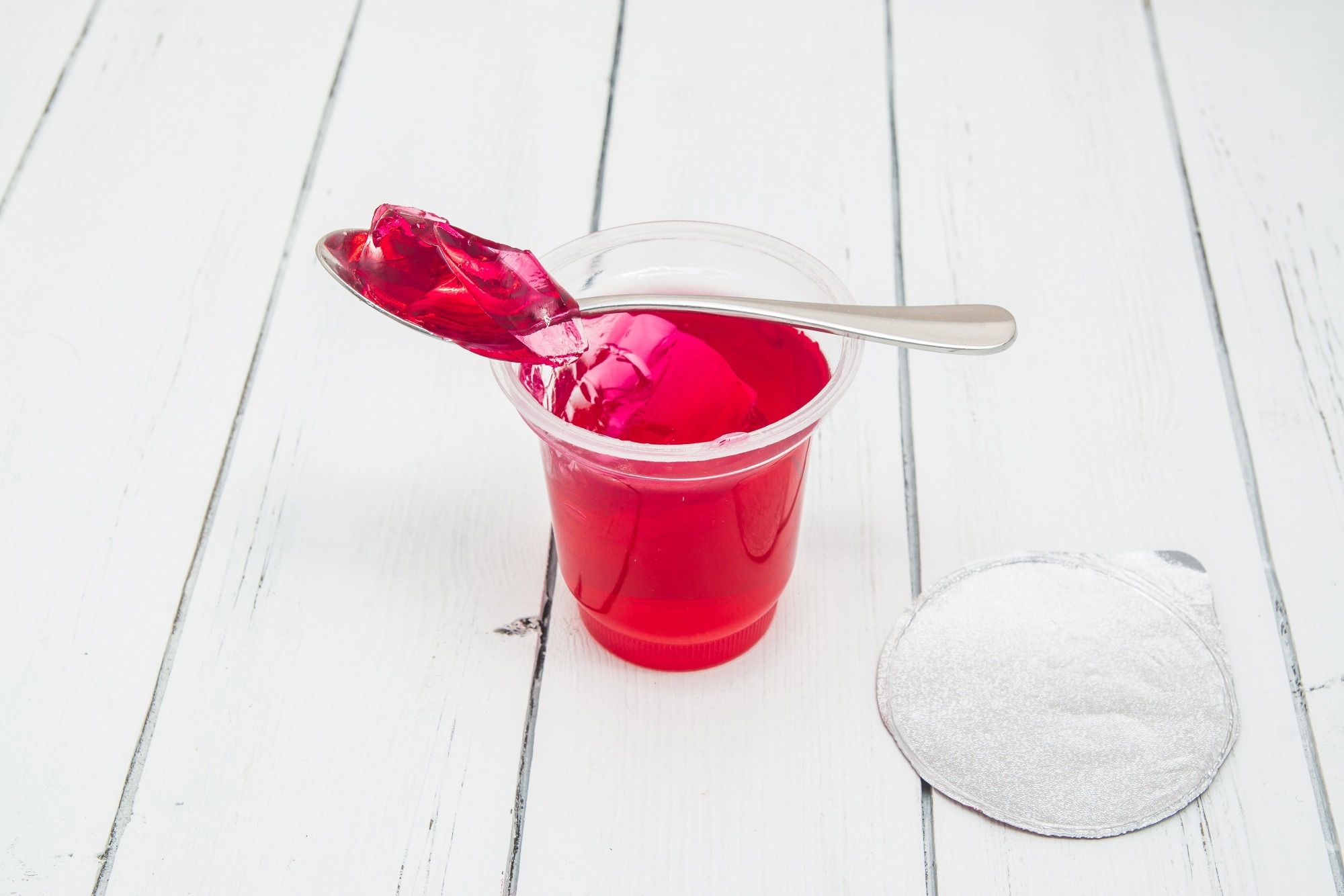
In an evolving health landscape, emerging research continues to highlight concerns that could impact everyday wellbeing. Here’s the key update you should know about:
Korean researchers have highlighted the exact fruit–vegetable mix that keeps low-sugar collagen jelly both flavorful and antioxidant-rich, proving that guilt-free “beauty snacks” are possible
Study: Physicochemical Properties and Sensory Evaluation of Low-Sugar Collagen Jelly Using Fruit and Vegetable Powder. Image credit: Anna Shkolnaya/Shutterstock.com
In a recent study published in Foods, researchers determined the fruit-vegetable powder level that maximizes antioxidant capacity and sensory preference in an erythritol-sweetened collagen jelly while maintaining desirable physicochemical properties.
Background
Many adults are trying to cut sugar intake for weight, skin, or glucose control, yet many “beauty” jellies remain sugar-dense. Collagen supports skin hydration and elasticity, while apples, carrots, and tomatoes supply polyphenols, flavonoids, carotenoids, and fiber that temper daily oxidative stress from pollution, light, and hectic routines.
Replacing sucrose with erythritol, a polyol with a zero glycemic index, can lower post-meal glucose without calories. However, low-sugar products frequently struggle to match traditional versions’ color, texture, and mouthfeel. Today’s consumers want indulgent snacks that still feel healthy. Determining the right amount of fruit-vegetable powder is key to striking that balance, and ongoing research aims to fill that knowledge gap.
About the study
Investigators prepared collagen jelly in six formulations by adding hot-air-dried apple, carrot, and tomato powders mixed 5:1:1 (w/w) at 0%, 2%, 4%, 6%, 8%, or 10% of total mass. A composite gelling system of konjac glucomannan, locust bean gum, and κ-carrageenan (1:0.8:0.2, w/w/w) was used.
Equal parts sucrose and erythritol (8.5 g each per 100 g) provided sweetness, with citric acid and 0.2 g of salt for flavor. Batches were heated (≈80 °C), molded, and set (4 °C, 24 h). Proximate composition followed the Association of Official Analytical Chemists methods; sugar was measured as degrees Brix with a refractometer after ultrasonic extraction in distilled water (DW).
Color used Hunter L (lightness), a (red-green), and b (yellow-blue) values. Texture Profile Analysis (TPA) quantified hardness, adhesiveness, cohesiveness, springiness, gumminess, and chewiness.
Antioxidant assays included Total Flavonoid Content (TFC) reported as quercetin equivalents (QE), Total Polyphenol Content (TPC) reported as gallic acid equivalents (GAE), and radical-scavenging capacity by 2,2-diphenyl-1-picrylhydrazyl (DPPH) and 2,2′-azino-bis(3-ethylbenzothiazoline-6-sulfonic acid) (ABTS), both expressed as vitamin C equivalents (VCE).
A 30-adult panel rated color, odor, taste, texture, and overall liking on a seven-point Likert scale. Statistics used one-way Analysis of Variance (ANOVA) with Duncan’s post hoc test in Statistical Analysis System (SAS) 9.4 at p<0.05. The protocol had Institutional Review Board (IRB) approval and informed consent.
Study results
Color shifted predictably with more fruit-vegetable powder. Lightness (L) fell from 34.83 at 0% to 23.60 at 10%, while redness (a) increased from −1.45 to 18.93 and yellowness (b) from 2.48 to 25.59, reflecting carotenoids from carrot and tomato and polyphenols from apple; all pairwise differences across concentrations were significant within rows (p<0.05). This deeper, warmer color aligns with what shoppers expect from fruit-forward products.
Proximate analyses showed moisture decreased as powder increased (≈50.89% at 0% to 39.70% at 10%), while crude protein, crude fat, and ash modestly increased, consistent with solids contributed by powders. Carbohydrates rose to ≈49.83% at 10%, and the jelly remained distinctly “low-sugar”: degrees Brix increased only from 2.43 (0%) to 3.63 (10%), far below sucrose-sweetened citrus jellies, typically around 21-23 °Brix. This matters for people monitoring glucose who still want a pleasant dessert.
Instrumental texture measurements corresponded well with the jelly’s perceived mouthfeel. Hardness increased with powder (1.32 N at 0% to 3.39 N at 10%), and adhesiveness remained low until rising at 8% and 10%. Cohesiveness peaked at 4% (≈0.68), then fell at higher levels (≈0.34 at 10%), indicating that too much powder disrupts a uniform gel network. Springiness rose toward 8% (≈0.72) before dipping, while gumminess and chewiness were highest around 8% and then declined to 10%. These data indicate an inflection near 8% where firmness, resilience, and ease of chewing feel “right” rather than brittle or gluey.
Phytochemicals rose with powder, as TFC increased from 1.58 mg QE/100 g (0%) to 14.99 mg QE/100 g (10%), and TPC from 12.72 mg GAE/100 g to 39.99 mg GAE/100 g. Antioxidant activity increased with powder concentration: DPPH radical-scavenging rose from 25.68 mg to 90.67 mg VCE/100 g, and ABTS from 12.68 mg to 51.72 mg VCE/100 g. Even at 8%, the jelly showed substantial gains (≈78.57 mg VCE/100 g for DPPH and ≈42.26 mg VCE/100 g for ABTS), highlighting its strong antioxidant potential without compromising taste or texture.
The sensory panel’s responses closely aligned with the instrumental findings. Among 30 adults, overall preference was lowest at 2% (≈3.17/7) and highest at 8% (≈4.30/7), with 8% also leading on odor and taste. Texture scores did not differ significantly across groups, a common occurrence when panel sensitivity is modest, yet the trend favored mid-to-higher powder levels.
Notably, 8% appeared to hit a sweet spot: deeper color, brighter fruit notes, stronger antioxidant readouts, and a firm-but-pleasant bite. The article notes that these findings may be useful for product developers designing low-sugar jellies for health-conscious consumers.
Conclusions
This study shows that an erythritol-sweetened collagen jelly can be both low in sugar and high in consumer appeal when formulated with a modest amount of fruit-vegetable powder.
Around 8% powder delivered the best overall preference while improving color, firmness, and antioxidant capacity (higher QEs, GAEs, and VCEs). Hardness and adhesiveness rose with more powder, but cohesiveness and springiness peaked at intermediate levels, cautioning against overloading solids.
While microbial stability and broader panels warrant future testing, the findings offer practical targets for developers and suggest potential applications in healthier choices for consumers seeking blood-glucose-friendly, antioxidant-rich treats.
Journal reference:
-
Yu, J., Park, S.J., & Lee, H.J. (2025). Physicochemical Properties and Sensory Evaluation of Low-Sugar Collagen Jelly Using Fruit and Vegetable Powder. Foods. 14(19). DOI: 10.3390/foods14193407. https://www.mdpi.com/2304-8158/14/19/3407

